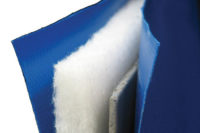A new approach to contain harmful noise

Loud noises from machinery, tools and assembly processes are an inherent part of many industrial workplaces, with banging, buzzing and grinding sounds largely tolerated as part of the job. However, neither the short- nor long-term consequences of prolonged noise exposure are something employees should accept.
In the short term, high levels of noise in a workspace can cause the feeling of being tired or a minor hearing disfunction, like a ringing in ears or the sensation of being “stuffed up.” But, in the long run, consequences can be much more severe – including increased stress, decreased productivity, a higher degree of worksite accidents and, in many cases, permanent hearing damage. The CDC even reported that prolonged noise exposure may be detrimental to more than just the ears, potentially affecting blood pressure and leading to cardiovascular diseases.
Since OSHA requires employers to limit employee noise exposure to 90 dB or less – preferably below 85 dBs – on an 8-hour time-weighted average basis, many workspaces have some safety measure in place to protect employees. Unfortunately, some methods are more effective than others, and OSHA estimates that millions are still affected every year by hazardous levels of workplace noise.
Common methods of sound control
The most common safety method is personal hearing protection such as earplugs or earmuffs. These PPE mainstays provide effective noise protection when properly fitted (and actually worn), but they can hinder verbal communication between employees.
Redesigning or replacing loud equipment with quieter models is another option, but the cost or availability of such equipment can often be prohibitive. Short of replacing louder machines, some noisy machines can be modified with isolation pads or vibration dampeners to reduce or eliminate excessive sound. Encasing machines in sound-absorbing enclosures or materials is another, lower cost option
Noise reduction barriers provide facilities with another option. Typically, they are rigid, insulated walls or partitions that are strategically placed to block sound and reduce potentially damaging noise from reaching nearby employees. These specially designed barriers obstruct the path of transmitted sound waves – absorbing and scattering them – to diminish the power of the emitted sound on the other side of the wall. While proficient in blocking noise, the construction of a wall can be costly and may require changes in daily workspace procedures to accommodate the building process.
Flexibility
In the place of constructed walls, fabric curtain walls make for a cost-efficient and flexible sound dampening alternative. Curtain walls can be fitted to virtually any space, even allowing for bends and corners. Their installation requires far less time and money than that of a constructed wall. They can be hung snugly from the ceiling to shield varying sections of a workspace from harmful noise.
Individual curtain panels of any length can be attached together using Velcro, making a continuous barrier with massive flexibility. They can be reconfigured or maneuvered as often as desired, offering boundless possibilities for layouts or potential changes in the workflow. Even if sound levels increase in a particular workspace due to a change in operations, an additional layer can be added to the curtain itself or to augment to an existing rigid wall (a common procedure).
Reducing sound
Acoustic curtain walls are normally comprised of two layers of a woven, coated fabric surrounding one or more layers of various insulating materials. These materials might include fiber batting (polymer or glass), open cell foam, or densified “loaded” vinyl or other flexible polymer sheet material.
Each component plays a vital role in reducing potentially harmful sound levels. The mass loaded vinyl sheet in a sound curtain is more effective in reducing lower frequency noise than the other components, as low frequency sound is best absorbed or deflected with high density solid materials. The fiber batting, on the other hand, is effective in combating sound at mid- to higher-range frequencies.
The interior core of a typical sound curtain will consist of a layer of sound-dampening, loaded vinyl and a layer of antimicrobial polyester batting as an additional sound buffer that fills out and maintains the body of the panel. This core is captured between two outer layers of 18-oz flame retardant vinyl, available in various colors for aesthetic appeal.
Multi-purpose, multi-use
Flexible curtain walls offer further advantages. These fabric-covered walls can be easily cleaned with simple detergent and water. Acoustic curtain walls not only mitigate noise transmission, but they have been engineered to provide thermal insulation for the prevention of condensate or frost buildup. They also protect against the movement of dust, fumes, smoke and other particles.
Constant loud noises in the workplace are a significant health hazard to employees. Flexible acoustic curtain walls offer a relatively new approach to providing employee safety and comfort. Modifying a workspace can be an expensive hassle, but it doesn’t have to be.
Disclaimer: The information herein is provided as a general reference regarding the use of the applicable product(s) in specific applications. This information is provided without warranty. It is your responsibility to ensure that you are using all mentioned products properly in your specific application and in accordance with all laws and regulations.
Looking for a reprint of this article?
From high-res PDFs to custom plaques, order your copy today!









